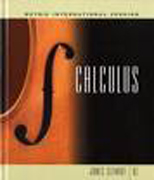
This Metric edition of James Stewart's best-selling calculus book has been revised with the consistent dedication to excellence that has characterized all his books. Stewart's Calculus is successful throughout the world because he explains the material in a way that makes sense to a wide variety of readers. His explanations make ideas come alive, and his problems challenge, to reveal the beauty of calculus. Stewart's examples stand out because they are not just models for problem solving or a means of demonstrating techniques – they also encourage readers to develp an analytic view of the subject. INDICE: 1. Functions and Models. Four Ways to Represent a Function. Mathematical Models: A Catalog of Essential Functions. New Functions from Old Functions. Graphing Calculators and Computers. Principles of Problem Solving. 2. Limits. The Tangent and Velocity Problems. The Limit of a Function. Calculating Limits Using the Limit Laws. The Precise Definition of a Limit. Continuity. 3. Derivatives. Derivatives and Rates of Change. Writing Project: Early Methods for Finding Tangents. The Derivative as a Function. Differentiation Formulas. Applied Project: Building a Better Roller Coaster. Derivatives of TrigonometricFunctions. The Chain Rule. Applied Project: Where Should a Pilot Start Descent?. Imlicit Differentiation. Rates of Change in the Natural and Social Sciences. Related Rates. Linear Approximations and Differentials. Laboratory Project:Taylor Polynomials. 4. Applications of Differentiation. Maximum and Minimum Values. Applied Project: The Calculus of Rainbows. The Mean Value Theorem. How Derivatives Affect the Shape of a Graph. Limits at Infinity; Horizontal Asymptotes. Summary of Curve Sketching. Graphing with Calculus and Calculators. Optimization Problems. Applied Project: The Shape of a Can. Newton''s Method. Antiderivatives. 5. Integrals. Areas and Distances. The Definite Integral. Discovery Project: Area Functions. The Fundamental Theorem of Calculus. Indefinite Integrals and the Net Change Theorem. Writing Project: Newton, Leibniz, and the Invention of Calculus. The Substitution Rule. 6. Applications of Integration. Areas between Curves. Volume. Volumes by Cylindrical Shells. Work. Average Value of a Function. 7. Inverse Functions: Exponential, Logarithmic, and Inverse Trigonometric Functions . Inverse Functions. (Instructors may cover either Sections 7.2-7.4 or Sections 7.2*-7.4*). Exponential Functions and Their Derivatives. Logarithmic Functions. Derivatives of Logarithmic Functions. *The NaturalLogarithmic Function. *The Natural Exponential Function. *General Logarithmicand Exponential Functions. Exponential Growth and Decay. Inverse Trigonometric Functions. Applied Project: Where to Sit at the Movies. Hyperbolic Functions. Indeterminate Forms and L''Hospital''s Rule. Writing Project: The Origins ofL''Hospital''s Rule. 8. Techniques of Integration. Integration by Parts. Trigonometric Integrals. Trigonometric Substitution. Integration of Rational Functions by Partial Fractions. Strategy for Integration. Integration Using Tables and Computer Algebra Systems. Discovery Project: Patterns in Integrals. Approximate Integration. Improper Integrals. 9. Further Applications of Integration.Arc Length. Discovery Project: Arc Length Contest. Area of a Surface of Revolution. Discovery Project: Rotating on a Slant. Applications to Physics and Engineering. Discovery Project: Complementary Coffee Cups. Applications to Economics and Biology. Probability. 10. Differential Equations. Modeling with Differential Equations. Direction Fields and Euler''s Method. Separable Equations. Applied Project: Which is Faster, Going Up or Coming Down? Models for Population Growth. Applied Project: Calculus and Baseball. Linear Equations. Predator-Prey Systems. 11. Parametric Equations and Polar Coordinates. Curves Defined byParametric Equations. Laboratory Project: Families of Hypocycloids. Calculus with Parametric Curves. Laboratory Project: Bezier Curves. Polar Coordinates. Areas and Lengths in Polar Coordinates. Conic Sections. Conic Sections in Polar Coordinates. 12. Infinite Sequences and Series. Sequences. Laboratory Project: Logistic Sequences. Series. The Integral Test and Estimates of Sums. The Comparison Tests. Alternating Series. Absolute Convergence and the Ratio and Root Tests. Strategy for Testing Series. Power Series. Representation of Functions as Power Series. Taylor and Maclaurin Series. Writing Project: How Newton Discovered the Binomial Series. Applications of Taylor Polynomials. Applied Project: Radiation from the Stars. 13. Vectors and the Geometry of Space. Three-Dimensional Coordinate Systems. Vectors. The Dot Product. The Cross Product. Discovery Project: The Geometry of a Tetrahedron. Equations of Lines and Planes. Cylinders and Quadric Surfaces. 14. Vector Functions. Vector Functions and Space Curves. Derivatives and Integrals of Vector Functions. Arc Length and Curvature. Motion in Space: Velocity and Acceleration. Applied Project: Kepler''s Laws. 15. Partial Derivatives. Functions of Several Variables. Limits and Continuity. Partial Derivatives. Tangent Planes and Linear Approximations. The Chain Rule. Directional Derivatives and the Gradient Vector. Maximum and Minimum Values. Applied Project: Designing a Dumpster. Discovery Project: Quadratic Approximations and Critical Points. Lagrange Multipliers. Applied Project: RocketScience. Applied Project: Hydro-Turbine Optimization. 16. Multiple Integrals.Double Integrals over Rectangles. Iterated Integrals. Double Integrals over General Regions. Double Integrals in Polar Coordinates. Applications of Double Integrals. Triple Integrals. Discovery Project: Volumes of Hyperspheres. Triple Integrals in Cylindrical. Discovery Project: The Intersection of Three Cylinders. Triple Integrals in Spherical Coordinates. Applied Project: Roller Derby. Change of Variables in Multiple Integrals. 17. Vector Calculus. Vector Fields. Line Integrals. The Fundamental Theorem for Line Integrals. Green''s Theorem. Curl and Divergence. Parametric Surfaces and Their Areas. Surface Integrals. Stokes'' Theorem. Writing Project: Three Men and Two Theorems. The Divergence Theorem. Summary. 18. Second-Order Differential Equations. Second-Order Linear Equations. Nonhomogeneous Linear Equations. Applications of Second-Order Differential Equations. Series Solutions. Appendixes. A: Intervals, Inequalities, and Absolute Values. B: Coordinate Geometry and Lines. C: Graphs of Second-Degree Equations. D: Trigonometry. E: Sigma Notation. F: Proofs of Theorems. G.Complex Numbers. H: Answers to Odd-Numbered Exercises.
- ISBN: 978-0-495-38362-8
- Editorial: Brooks-Cole
- Encuadernacion: Cartoné
- Páginas: 1368
- Fecha Publicación: 01/01/2009
- Nº Volúmenes: 1
- Idioma: Inglés
- Inicio /
- MATEMÁTICAS /
- CÁLCULO
